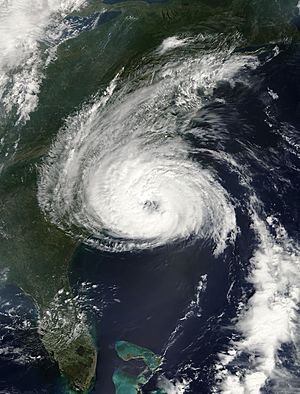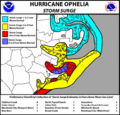Hurricane Ophelia (2005) facts for kids

Hurricane Ophelia near North Carolina on September 14
|
|
| Meteorological history | |
|---|---|
| Formed | September 6, 2005 |
| Extratropical | September 18, 2005 |
| Dissipated | September 23, 2005 |
| Category 1 tropical cyclone | |
| 1-minute sustained (SSHWS/NWS) | |
| Highest winds | 85 mph (140 km/h) |
| Lowest pressure | 976 mbar (hPa); 28.82 inHg |
| Overall effects | |
| Fatalities | 1 direct, 2 indirect, 1 missing |
| Damage | $70 million (2005 USD) |
| Areas affected | Bahamas, East Coast of the United States, Atlantic Canada |
|
Part of the 2005 Atlantic hurricane season |
|
Hurricane Ophelia was a powerful storm that lasted a long time in September 2005. It moved in a very unpredictable way near the East Coast of the United States. Ophelia was the fifteenth storm to be named and the eighth hurricane during the very busy 2005 Atlantic hurricane season.
Contents
How Hurricane Ophelia Formed and Moved
Ophelia started from a mix of weather systems in the Atlantic Ocean in early September. A low-pressure area, which is like a swirling area of air, formed near the Bahamas. On September 6, this system became Tropical Depression Sixteen.
The storm was stuck in an area with very weak steering currents. This meant it didn't have strong winds to push it in one direction. Because of this, Ophelia moved in a looping path, generally heading north.
The next day, it grew stronger and became Tropical Storm Ophelia. By September 8, it was strong enough to be called a hurricane.
Over the next week, Ophelia kept changing its strength. It would go from a tropical storm back to a hurricane and then weaken again. This happened because of dry air, changing wind conditions, and cooler ocean waters.
The storm also grew larger over time. On September 14, Ophelia reached its strongest point for the fourth time. It had winds of 85 miles per hour (140 km/h). By this time, it had completed another loop and was moving toward North Carolina.
Ophelia changed direction again and moved away from North Carolina. However, the strongest part of the storm, called the eyewall, brushed against the coastline for two days.
On September 16, Ophelia weakened to a tropical storm one last time. It then started to move faster toward the northeast. The storm eventually changed into an extratropical cyclone, which is a different type of weather system, on September 17.
For the next week, Ophelia continued moving east-northeast. It traveled across Atlantic Canada and the northern Atlantic Ocean. Finally, it disappeared on September 23 over the Norwegian Sea.
Getting Ready for the Storm
Because Ophelia moved in such an unpredictable way, many warnings were issued along the Eastern Seaboard. This was a much larger area than actually needed to be warned.
Hurricane Katrina had just happened, so state governments were very quick to prepare. They opened shelters to keep people safe. Members of the United States National Guard were sent to North Carolina. Thousands more were ready to help in North Carolina and South Carolina.
More than 2,000 people went to public shelters as Ophelia got closer to land. Everyone wanted to be extra careful after the recent big storms.
What Happened After the Storm
Luckily, the center of Hurricane Ophelia mostly stayed offshore. This meant the damage was much less than people had feared.
Some places along the coast received a lot of rain. The Outer Banks in North Carolina, for example, got more than 15 inches (380 mm) of rain.
The biggest problems were in North Carolina. Over 240,000 homes lost power, and more than 1,500 homes were damaged. The total cost of the damage in North Carolina was about $70 million.
The long-lasting effects of the hurricane caused a lot of beach erosion. This means sand was washed away from the beaches.
Some areas like Florida, Massachusetts, and South Carolina had minor damage. This was mostly from strong winds and heavy rain.
Sadly, rough seas caused one person to die in Florida. Another person went missing in South Carolina. In North Carolina, a car accident happened on a wet road, which led to another death. In Atlantic Canada, one person died after falling from a roof while getting ready for the storm.
After the hurricane, 37 counties in North Carolina were declared disaster areas. This meant they could get special help. The Federal Emergency Management Agency (FEMA) provided about $5.2 million to help public services. The National Guard also helped give out supplies to people who needed them.
Images for kids
-
Many coastal buildings were damaged by strong winds and storm surge in Bogue Banks, North Carolina.








